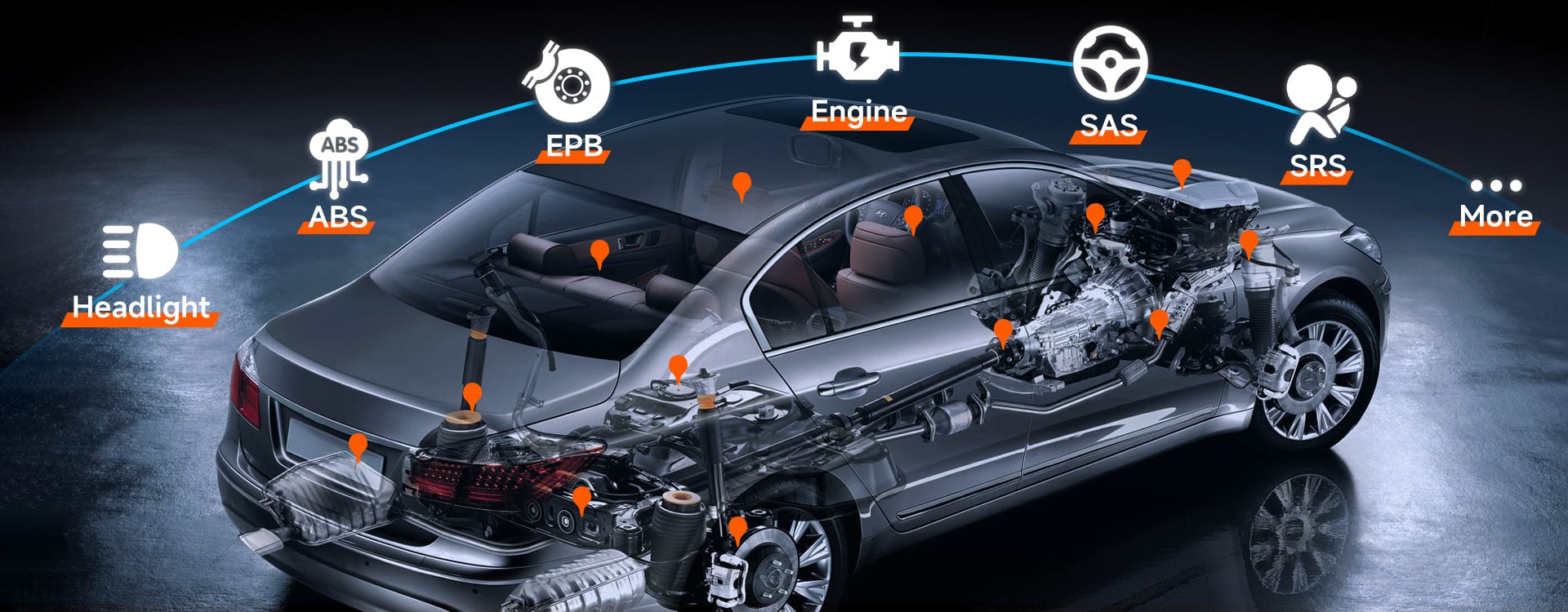Navigating the world of automotive diagnostics can often feel like deciphering a complex language. With the advent of On-Board Diagnostics II (OBD2) systems, car owners and technicians have gained powerful tools to understand vehicle health. Among the myriad of codes that can surface, “Htr Code Obd2” might raise questions. This article breaks down what HTR codes signify in the context of OBD2 systems, helping you understand your car’s diagnostic language and how to address potential issues effectively.
 Car Scanner Functions | Foxwell
Car Scanner Functions | Foxwell
Understanding OBD2 and Diagnostic Trouble Codes (DTCs)
Before diving into HTR codes, it’s crucial to grasp the basics of OBD2. Since the mid-1990s, OBD2 has been a standardized system in vehicles, designed to monitor the performance of the engine, emissions controls, and other vital systems. When the system detects an issue, it generates a Diagnostic Trouble Code (DTC), signaling that something is not operating as expected. These DTCs are invaluable for pinpointing problems, ranging from minor sensor glitches to significant mechanical failures.
OBD2 scanners are the tools that allow you to communicate with your car’s computer and retrieve these DTCs. From basic handheld readers to advanced professional scan tools like the Foxwell GT60, these devices empower users to understand what’s happening under the hood.
Decoding HTR Codes: Heater Circuit Diagnostics
Within the realm of OBD2 codes, “HTR” specifically refers to “Heater.” In automotive terms, this almost always relates to the heater circuits associated with oxygen sensors. Modern vehicles utilize oxygen sensors (O2 sensors) to monitor the oxygen content in the exhaust stream. This information is critical for the engine control unit (ECU) to optimize fuel mixture and ensure efficient catalytic converter operation, thus reducing emissions.
To function optimally, especially during cold starts, oxygen sensors are equipped with heaters. These heaters bring the sensors to their operating temperature quickly, allowing for accurate readings sooner. An “HTR code OBD2” therefore indicates a problem within the heater circuit of an oxygen sensor.
Common HTR Codes and Their Meanings
When your OBD2 scanner flags an HTR code, it’s often accompanied by a specific numeric code that provides more detail. Here are some of the most common HTR-related OBD2 codes:
- P0135: O2 Sensor Heater Circuit Malfunction (Bank 1, Sensor 1). This indicates a problem with the heater circuit for the upstream oxygen sensor on bank 1 (the side of the engine containing cylinder #1).
- P0141: O2 Sensor Heater Circuit Malfunction (Bank 1, Sensor 2). This points to an issue with the heater circuit for the downstream oxygen sensor on bank 1 (sensor located after the catalytic converter).
- P0155: O2 Sensor Heater Circuit Malfunction (Bank 2, Sensor 1). Similar to P0135, but for bank 2.
- P0161: O2 Sensor Heater Circuit Malfunction (Bank 2, Sensor 2). Similar to P0141, but for bank 2.
These codes generally mean that the ECU has detected an electrical fault in the heater circuit of the specified oxygen sensor. This could be due to:
- A faulty oxygen sensor heater: The heating element within the sensor itself has failed.
- Wiring issues: Broken, shorted, or corroded wiring in the heater circuit.
- A blown fuse: The fuse protecting the heater circuit has blown.
- ECU malfunction (rare): In rare cases, the ECU itself might be misinterpreting the circuit or have an internal issue.
Diagnosing and Addressing HTR Code OBD2 Issues
When faced with an HTR code, a systematic approach to diagnosis is essential:
- Record the Code and Research: Use your OBD2 scanner to note down the specific code. Consult a reliable repair database or your vehicle’s repair manual to understand the specific sensor and circuit involved.
- Visual Inspection: Carefully inspect the wiring and connectors leading to the affected oxygen sensor. Look for any signs of damage, corrosion, or loose connections.
- Check the Fuse: Locate the fuse box and identify the fuse for the oxygen sensor heater circuit (refer to your car’s manual). Check if the fuse is blown and replace it if necessary. If it blows again immediately, there’s likely a short circuit.
- Test the Heater Circuit: Using a multimeter, you can test the resistance of the oxygen sensor heater. A reading outside the manufacturer’s specification indicates a faulty sensor. You can also check for voltage at the connector to ensure power is reaching the heater circuit.
- Sensor Replacement: If the sensor heater is confirmed to be faulty, replace the oxygen sensor with a new, quality replacement.
- Clear the Code and Re-test: After repairs, use your OBD2 scanner to clear the DTC. Then, drive the vehicle under conditions that would typically trigger the code to see if it returns.
While the original article you provided discussed “Hardware Recovery Technology” (HRT) in the context of advanced scanners recovering from hardware failures, it’s important to note that HRT, in that specific definition, isn’t directly related to diagnosing “HTR codes” in the OBD2 system. However, high-quality diagnostic tools, including those with advanced features, are invaluable for accurately reading and interpreting OBD2 codes like HTR codes, and for performing some reset or recalibration procedures that might be needed after repairs. Tools like the Foxwell GT60, mentioned in the original article, provide comprehensive diagnostic capabilities that can certainly assist in addressing issues indicated by HTR codes, even if they don’t directly employ “Hardware Recovery Technology” to fix a faulty sensor heater circuit.
Conclusion
Understanding “HTR code OBD2” empowers you to effectively diagnose and address heater circuit issues within your vehicle’s oxygen sensor system. While these codes might seem daunting at first, recognizing that “HTR” signifies “Heater” and relating it to the oxygen sensor function provides a clear starting point for troubleshooting. By following a logical diagnostic process and utilizing OBD2 scanners, you can maintain your vehicle’s performance, fuel efficiency, and emissions control systems, ensuring a healthier car and a cleaner environment.
